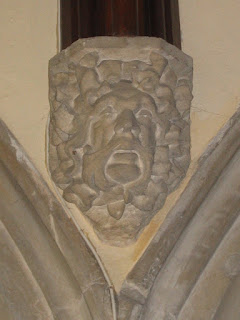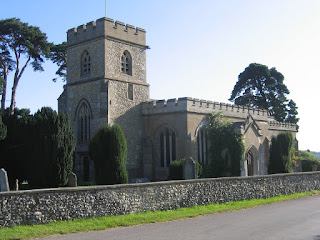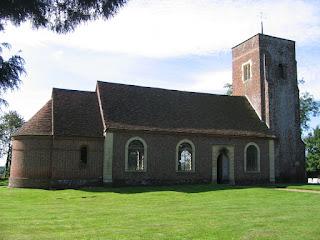I recently checked out a couple of churches to the south of Royston, one of which had a rather splendid Green Man in it, but I had no camera on me on the day (it was a last minute decision to travel out).
So, being a Bank Holiday weekend, I decided to return to the area to get a picture, and to look at some other churches. The route took us up the A10, doubling back down to the A120 via several villages to the east. With a total of 11 churches visited, this turned into quite a long trip to write up!
Buckland, St Andrew
Buckland is a small hilltop settlement, just off the A10. It now comprises not much more than a dozen or so houses and a farm. The church is now tended by the
Churches Conservation Trust, but still caters for around half a dozen services a year. The church is usually locked, but a (very large) key is available from a couple of the nearby houses.
Although the church underwent a major restoration in the late 1800's, there are still several stone corbel heads to be seen, both inside and outside, but sadly no Green Men that I could spot.
Reed, St Mary
St Mary's is described as an 'isolated Saxon Church', and is built on one of the highest points in Hertfordshire, slightly apart from the main village. It has been noted that apart from St Alban's Cathedral, no other Hertfordshire church has as much Saxon work visible.
Inside, the Rood stairs disappear into the wall, and the North Door appears only as a round headed recess. Externally however, the North Door is preserved almost intact in it's original form.
But again, no evidence of the elusive Green Man.
Barkway, St Mary Magdelene
This is the church that sparked this particular trip, as I'd been here a couple of weeks ago, without a camera. The main attraction of the church is the Burma Star window - a commemorative stained glass window in memory of the Burma Star Association. But my attention was drawn upwards in the nave and north aisle, where a succession of carved figures and heads appear. The finest of these is at the east end of the north aisle, where a fine Green Man foliate head looks down. Unfortunately, I found this difficult to photograph both with and without flash giving less than ideal results:
At the west end of the north aisle, was another foliate head, this time more leonine in nature and even more difficult to photograph due to the intrusion of a vestry room into the aisle, leaving only a very short space below the head to photograph from. Maybe I need yet another trip with the camera mounted on a pole to capture this one?
Anstey, St George
No Green men, but a couple of items that are worth mentioning here. The church is near the site of Anstey Castle, and it's thought that some of the stone from the castle was used in rebuilding the church - the chancel walls have some notable military-style 13th century graffiti, and it's possible that these were originally drawn on the castle walls.
Also in the chancel are 12 old stalls, which include a number of miserichords. One of these is a 'tongue-poker' image, possibly dating from the 1400s.
The design on the Norman font is described in the church information leaflet as being 'four mermen holding their split tails with both hands, making a symmetrical pattern along the four sides of the bowl...possibly symbolic of the Ark of Christ's Church. Such a motif is rare, occurring in only one other place in England - St Peter's, Castle Street, Cambridge'. Whilst I can understand this interpretation, my first impression was of four men in Viking Longships, possibly pointing to an even earlier origin for the church building. I guess it depends what you expect to see!
Wyddial, St Giles
A service was in full flow when I arrived, so I was unable/unwilling to enter the church. The exterior gave no real clues as to its possible contents.
Great Hormead, St Nicholas
The first of the two Hormead churches which lie some 300 yards apart, St Nicholas is the present church for the parish, and was first built in the 1200s. There are some quite remarkable carved heads both within and without the church.
In the south aisle is a most horrendous head, being both a mouth-puller and a nose picker at the same time! Flash photography sadly does not do it justice. There is also what can only be described as a 'Cheshire Cat' type face, grinning away like it's just stepped out of a Lewis Carrol story, although it predates the books by a few hundred years...
Externally, there are a series of grotesque heads, one of which resembles a Wild Wose with animal (donkey?) ears, and another with a single flower in it's mouth. Neither is really a Green Man, but the closest I found in this church. The latter head resembles another inside which has two similar flowers in its mouth.
Little Hormead, St Mary
Another church under the control of the
Churches Conservation Trust, the sign in the porch states that 'the church is always kept open'. Oh no it isn't! The door was firmly locked on my visit, though I understand that services are still held here in the summer months. Still, this was only my second access failure of the day.
The brick-built porch tells a story of earlier times, as a scratched sundial can be seen on the wall by the door. On my visit, someone had been busy with the coloured chalk, as images of the Virgin Mary were very much in evidence.
Brent Pelham, St Mary
The church at Brent Pelham is extraordinarily 'cavernous' inside. There are a pair of old stocks just outside the church gate, but the main item of interest inside is the tomb in the north wall of one O Piers Shonks, Dragonslayer, who died in 1086!
The story goes that he killed a great serpent. This so enraged the Devil that he swore he would claim Shonks for his own, whether he was buried inside the church, or out. Shonks was buried in the fabric of the north wall, which was neither in nor out, thus frustrating the Devil.
I'm not sure the church wall is actually that old, but it's a wonderful story.
Furneux Pelham, St Mary
Having had very little luck (other than Barkway) on the Green Man front, I was starting to despair. That changed at Furneux Pelham, in a surprising way. No stone heads here.
Tucked away at the end of the south aisle was an enormous wooden cabinet, some eight feet tall. The parish chest? There was no guide book or leaflet to help me so I can only guess as to its origin or why it was there. But the cabinet was covered in all manner of grotesque carved heads.
Some had a distinct Japanese or Polynesian feel, but there were also several foliate heads in the mix, which seemed to be in a state of anguish.
The chest did not fit with the 'feel' of the rest of the church, which was quite light and airy with brightly painted angels in the rafters. It felt quite sinister, and I'd love to know the story behind it.
Albury, St Mary
There was no information leaflet here, and the only item I noted of interest was the tomb of Sir Walter de la Lee and his wife, Margaret'. Both seemed impossibly small - Sir Walter's armour is of a style from King Richard II's time. The only surviving inscription reads:
SR WALTER AT LEA, AL'S SIR WALTER AT CLAY 1350 TO CIRCA 1395
Little Hadham, St Cecilia
The final stop on what was a very long day, and once again, no substantive reward. There are several carved corbels inside, but none of a design that is of interest here. Externally, the tower also holds some carved corbels and gargoyles, but I was unable to get a clear view of any details with my small camera.
Eleven churches (a personal record for a single day), only one of which has a 'true' Green man, but which all have their own curiosities and stories to tell. I'm beginning to really enjoy this journey!


























































